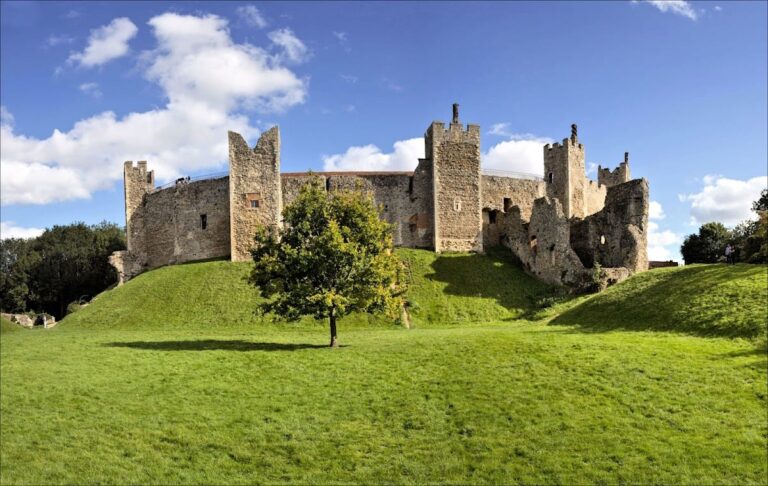Landguard Fort: A Historic Coastal Defense Site in Felixstowe, UK
Visitor Information
Google Rating: 4.6
Popularity: Medium
Google Maps: View on Google Maps
Official Website: www.landguard.com
Country: United Kingdom
Civilization: Unclassified
Remains: Military
History
Landguard Fort is located at Felixstowe in the United Kingdom and was originally constructed by the English to defend the harbor approaches. Its origins trace back to the mid-16th century when initial earthworks and a blockhouse were established around 1540 to protect the estuary. The site was initially known as Langer Fort before King James I, in 1621, ordered the construction of a more substantial square fortification featuring bulwarks, or projecting defensive walls, at each corner.
The fort’s military importance was demonstrated during the Second Anglo-Dutch War in 1667, when it successfully resisted a Dutch assault led by the notable naval commander Michiel de Ruyter. Despite facing a force of around 2,000 men, Landguard was defended by a modest garrison of approximately 500 soldiers armed with muskets and artillery, and outfitted with 54 cannons. This defense helped secure the vital harbor and surrounding coast.
Throughout the 18th and 19th centuries, Landguard Fort underwent several phases of expansion to enhance its defensive capabilities. Significant works included the addition of a battery in 1717 and, starting in 1745, the construction of a new fort with a pentagonal bastioned design, improving coverage and resistance against attacks. In the mid-1700s and into the 1780s, further batteries were added, reflecting ongoing military concerns during periods of European conflict.
During the Napoleonic Wars, the fort remained a critical defensive position. In 1801, General Lord Cornwallis inspected the site, but by 1804, concerns about the safety of ammunition stores led to their removal to Harwich, suggesting logistical adjustments in response to changing military strategy.
A major reconstruction in the 1870s revamped much of the fort’s structure. This included rebuilding internal barracks in a style reminiscent of a keep, replacing the river-facing defenses with a casemated battery—a fortified gun emplacement protected by overhead cover—and enclosing several previously open bastions. Notably, a unique caponier, a covered passage used to defend the moat, was constructed with a quarter-sphere shaped bombproof nose. Additionally, a mock ravelin, a triangular defensive work, was built to house a submarine mining unit, demonstrating the evolving nature of coastal defense technology.
In the 20th century, Landguard Fort adapted to new forms of warfare. During World War II, from 1942 to 1944, it served as a launch site for Operation Outward, an innovative campaign involving hydrogen balloons carrying incendiaries or steel wires aimed at disrupting German infrastructure. The fort also functioned as the command center for coastal artillery protecting Harwich Harbour, equipped with radar from 1944 to aid in targeting. By 1941, it was armed with multiple coastal guns and a twin six-pounder battery for close defense.
Besides artillery, Landguard was the headquarters for heavy anti-aircraft operations until 1941, operated a naval signal station to control ship movements, and remotely controlled defensive minefields across the harbor. Observers stationed there kept watch for enemy air raids, minelaying activities, shipwrecks, and aircraft crashes. In 1944, the gunners mistakenly fired upon supposed German midget submarines, reflecting the tension of wartime defense.
Following the war, military use declined, and the army left the site in 1957. Since then, the fort has been preserved and maintained as a historic monument, acknowledging its long-standing role in coastal defense and military history.
Remains
Landguard Fort retains a distinctive layout characterized by its historical evolution from a square fort with corner bulwarks to a robust pentagonal bastioned structure. The fortress is constructed primarily of brick and concrete, with reinforced walls forming strong defensive bastions. Its moat is crossed by a covered walkway known as the Caponier, which features a bomb-resistant quarter-spherical nose designed to withstand artillery attacks.
The internal barracks, rebuilt during the 19th-century renovations, resemble a small keep and contain a variety of functional rooms. These include barrack rooms for soldiers, administrative offices, a guardroom, and a gunpowder magazine equipped with mechanical lifts for cartridges. The fort also houses specialized spaces such as a radio and Morse code room, a plotting room for coordinating seaward defenses, a washroom, a schoolroom, and a tearoom, reflecting the comprehensive nature of the garrison’s activities.
Bastions named The Holland and The Chapel stand as prominent defensive features, each containing numerous gun ports that once held artillery pieces. On the river-facing side, the Right and Left Batteries provide well-preserved concrete gun emplacements dating from World War II. These housed four 6-inch guns and two twin six-pounder guns, arranged to defend against naval threats. One gun pit within the Left Battery was converted into an Anti-aircraft Operations Room in 1939, illustrating adaptation to new defense strategies.
The main entrance retains its original design, including a guardroom and a protected passageway, indicating the controlled access to the fort’s interior. Throughout the site, several open bastions were enclosed during 19th-century upgrades, enhancing their protective capabilities. The mock ravelin constructed for the submarine mining contingent adds a unique architectural feature, intended to support underwater defense efforts.
On display within the fort are replica 12.5-inch rifled muzzle-loading guns, providing a tangible link to the artillery once deployed here. Sections of submarine mines and World War II anti-aircraft guns, including Bofors 40mm cannons, complement the collection, illustrating the breadth of weaponry associated with the fort’s long history. Many of these elements remain in situ or have been carefully restored, offering insight into the military functions and technological developments carried out at Landguard over several centuries.
The location also offers expansive views over the River Orwell, the docks of Felixstowe, Harwich Harbour, and the surrounding peninsula. These vantage points on the roofs of batteries and bastions underscore the fort’s strategic position controlling key waterways and coastlines. Together, the surviving structures and artifacts provide a vivid record of Landguard Fort’s evolution as a critical defensive installation from Tudor times through the Second World War.










